Comics: Charlton Comics
Compiled by Martin Willey
Charlton employed some artists directly, notably Steve Ditko, but their low rates meant they regularly lost talent to Marvel and DC. They also worked with freelancers, particularly the company Continuity Associates, a studio run by artists Neal Adams and Dick Giordano (the latter a former Charlton editor and artist). The art editor of the magazine, Gray Morrow, was also freelance, but was a close friend of Charlton editor Nick Cuti. There were several Spanish artists employed as freelancers, at least initially via Continuity Associates. The Spanish art agency Selecciones Ilustradas had broken into the US market in 1971, supplying art to Warren Publishing. Some of the artists from the Spanish agency arrived in the US in the mid-1970s, mostly working with Continuity Associates.
Gray Morrow (1934-2001, wikipedia) was a comic strip artist, for Warren's horror comics, Marvel, D.C., Heavy Metal and others. He co-created the Man-Thing for Marvel Comics. He also painted book covers, including for the American Perry Rhodan books. He worked on animation with Ralph Bakshi for Spiderman TV series (1968), Fritz the Cat (1972) and Wizards (1977). He was nominated for the Hugo Award for artist in 1966, 1967, and 1968. He was a guest at the 1982 Space: 1999 convention. He described how he became involved:
"I was contacted by Gail Munn, who was the agent for ITC, to come for a private screening of this fabulous new series that was going to appear on television here in the states. She wouldn't tell me at the time what my part in it was supposed to be; she wanted to build up a little suspense. I went and met the English representative and watched what I thought was a pretty damn good show, which I guess was the first episode. Then they asked me if I'd be interested in doing a Space: 1999 comic book, and we went from that. When you're working with a two-dimensional medium and you're trying to compete with a three-dimensional one, your best shot is to make the stories wilder or further out. In other words, attempt to do something they couldn't do on film, at least not inexpensively. I don't know how successful we were. I knew the writer Nick Cuti was very enthusiastic and worked very hard on making them as entertaining as possible."
Says Cuti:
"Since Space 1999 was created in England, they needed an American contact to do the magazines and the rights were given to Hanna-Barbera. George [Wildman] and I had a meeting With the representatives of H-B and they were very happy with Joe Staton (for the comic) but they wanted a more realistic approach for the black-and-white magazines. Gray Morrow was a good friend at the time and was fantastic at realistic comic-book art. I suggested him and the people at H-B were familiar with his work and agreed. Later, Gray suggested Neal Adams' Continuity studio as a backup, and we had the magazines covered."
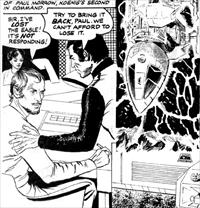
Gray Morrow was not allowed to use the likeness of Prentis Hancock for Paul Morrow, so he drew a self-portrait. Morrow was the main artist for magazine, and painted all the covers.
Joe Staton (1948-, wikipedia) started at Charlton in 1971, and created the series E-Man with Joe Gill. He then went to work for Marvel, on Spiderman and Incredible Hulk, before several stints at DC, notably on the Justice Society of America and several times on Green Lantern. From 2011-2021 he was the main artist on the Dick Tracy syndicated strip
Nick Cuti in Back Issue (2020): "Joe Staton was our premiere artist, and after the demise of E-Man we needed to give Joe work. So I wrote the first few issues of Space 1999 with Joe in mind."
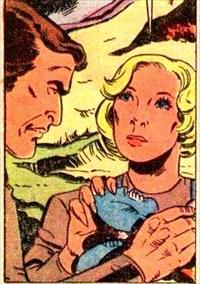
Joe Staton did the covers and stories for the colour comics issues #1 and #2; he also redrew the faces of Landau and Bain in Byrne's art for #3.
John Byrne (1950-, wikipedia) was born in the UK, and moved to Canada as a child. He began freelancing, with his first professional strip being in 1975 for Nicola Cuti at Charlton. After several TV-themed comics for Charlton, he was recruited to Marvel, working on X-Men from 1977 and other titles; in 1986 he went to DC to revive Superman, and later worked on Wonder Woman and Spiderman.
On Space: 1999, Byrne was especially good at figures, dynamic layout and narrative. In 2020, Byrne said of his first issue, number 3 (Back Issue #120 p31,32, interview by John Kirk):
"It was a nightmare. The Anderson reps completely rejected my first issue. They said I had the characters move their faces too much. Joe Staton redrew all the likenesses, and in subsequent issues I just copied what he'd done. The main characters ended up looking like they belonged on Easter Island. Pretty much all the wind was taken out of my sails by what I felt was the butchering of that first issue. I'd been really quite proud of the job I'd done.". His opinion of the show: "The tech and the aliens! The costumes and acting didn't thrill me, and I thought the premise was absurd, though when I was offered the comic, I saw a lot of potential fun to be had with the technology. The Eagles were a hoot to draw. I'd been a big fan of Supermarionation since discovering Supercar when I was a kid. I'd followed the Anderson product through Fireball XL5, Stingray, Captain Scarlet and the rest. I was also a big fan of UFO at the time."
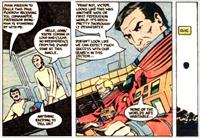
Byrne did the covers and stories for colour comics #2-#6, and also wrote the story for #6. The faces of the main characters in #3 were reworked by Joe Staton because of ITC demands.
Vicente Alcazar (born 1944, wikipedia) was born in Spain and initially worked with Carlos Pino in collaboration on Spanish comics, and in the 1960s for Fleetway comics in the UK. In 1969, they worked together on the British TV21 comic, based around Gerry Anderson's series', working on Star Trek and The Saint. In 1974 they went to the US, where they met Neal Adams and worked out of the Continuity Associates offices in New York. Alcazar would continue to work in US comics.
Alcazar worked particularly in horror for Marvel, DC and Charlton, as well as many other comic book genres. His most famous work was DC's western Jonah Hex (1978-1979)
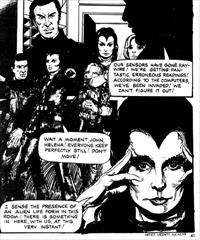
Alcazar was credited on "Snowball" in magazine #6, "The Infinity Mechanism" in #7 and "The Primary Life Form" in #8. Uncredited strips include "E Pluribus Unum" and "The Mind Of The Snark" in #2, "The Old Gods Are Not Eternal" in #3 and "Another Name For Hell" in #4.
Dick Ayers (1924-2014, wikipedia) was a freelancer who co-created Ghost Rider in 1949 (and later worked on the 1960s Marvel revival). He became best known as inker with Jack Kirby on The Fantastic Four and many westerns, and the first or early appearances of many of Marvel's superheroes, including Ant-man, Thor and the Incredible Hulk. After inking Kriby's Sgt Fury and his howling commandos, he became the main penciler for 10 years.
Aaron "Pat" Boyette (1923-2000, wikipedia) was a radio and TV journalist and film maker who also worked as a comic strip artist. In 1966 he and writer Joe Gill co-created the character Peacemaker for Charlton. He wrote and drew many stories for Charlton, DC and Warren.
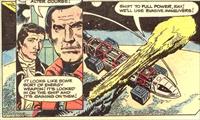
For the magazine, Boyette drew The Strange Ones (#5); for the colour comic, he draw the cover and both stories for #7.
Adolfo Buylla (1927-1998) was another Spanish comic book artist, known for his 1950s Spanish science fiction series Diego Valor. From the 1970s he began to work for US and UK comics, including DC, Marvel, Warren and Gold Key horror comics. He worked on Doctor Who for Marvel UK in 1981-1982.
Carlos Pino (born 1940, wikipedia) worked with Vicente Alcazar on Spanish and UK comics, and both moved to the US in 1974. Pino returned to Europe to work mainly for UK comics.
Pino worked on Invasion! for 2000 AD (1977-1978) and the Judge Dredd strips for the Daily Star (1991-1996). Since the mid 1990s he has worked for DC Thompson on their Commando was strips.

Pino drew "A Lonely Emperor" (uncredited) for magazine #4 and "The Perpetual Metamorphosis" (credited) for #7.
Continuity Associates was an art studio founded in New York in 1971 (wikipedia) by artists Neal Adams (1941-2022, wikipedia) and Dick Giordano (1932-2010, wikipedia). The founders worked with a staff of junior artists to produce comic art for advertising and general publishers, as well as established comic book publishers, particularly Marvel, DC and Charlton. Giordano had been an artist at Charlton Comics from 1952, becoming editor from 1965-1968, after which he moved to DC, where he worked as an editor and an inker with Neal Adams. Among the artists who worked with Continuity, at least for a while, were Gray Morrow, Vicente Alcazar and Carlos Pino. Collectively the artists were often known as the "Crusty Bunkers".
To keep tight deadlines, multiple artists would work on strips. Senior artists including Adams and Giordano would rework the more junior artists layouts. Sometimes they would ink the main characters, while junior artists would work on backgrounds.
Charlton already depended on Continuity Associates for some comic art, and they were used heavily for the 3 "magazine" format comics they produced, The Six Million Dollar Man, Emergency! and Space: 1999. According to Giordano quoted in Space: 1999 Comic Anthology (2023), ITC insisted the original artwork belonged to them, which Continuity refused to accept. Continuity Associates also produced the comic books for Power Records. Adams did the Power comic covers and penciling for the interiors, with Giordano doing the inking, assisted by Rich Buckler (1949-2017, wikipedia) and Frank McLaughlin (1935-2020, wikipedia). As with the Charlton comics, they were told by ITC not to use any likenesses except for Landau, Bain and Morse, so Ouma is white and Paul Morrow is shown just as Gray Morrow had drawn him in the Charlton magazine- as Gray Morrow.
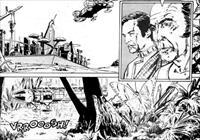
Continuity artists who worked on Space: 1999 include include Carl Potts (1952-, wikipedia), Doug Beekman (1952-, SF encyclopaedia) and Ed Davies. Pencils by Potts and Beekman, inks by Ed Davies for "Cosmic Headache" in magazine #7. They possibly did the uncredited art in "Class Determination: Alien Insecta" in #4, and perhaps others.